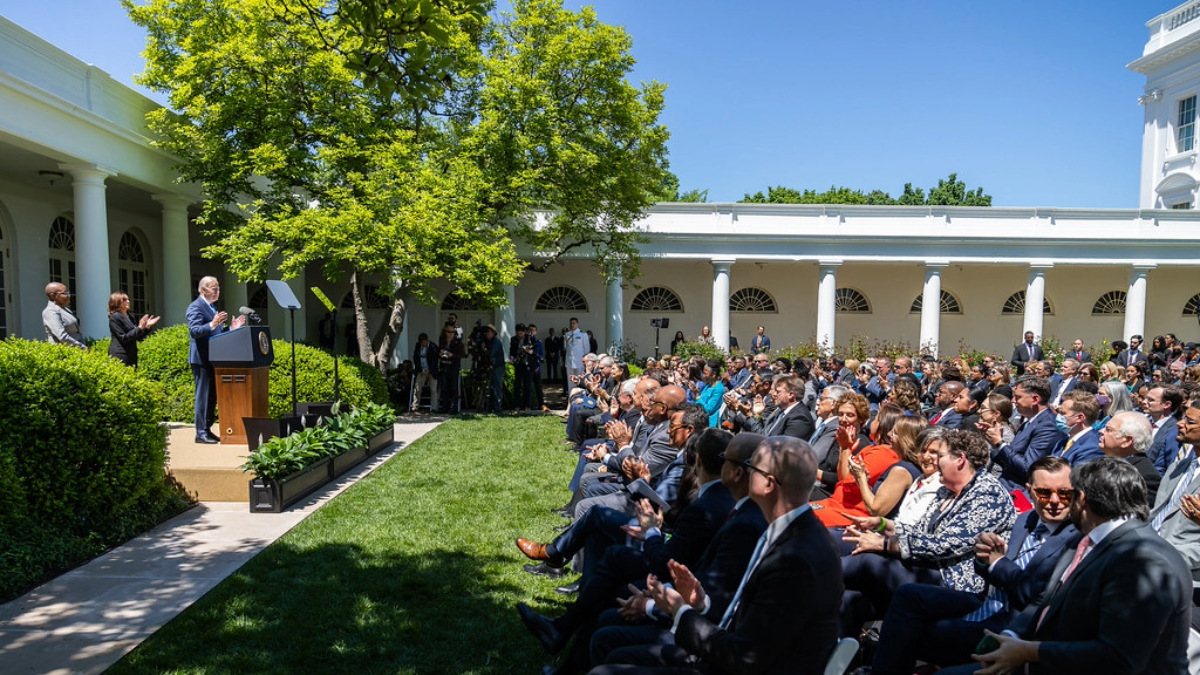America, Disconnected: What’s Biden’s Plan for Averting Digital Disaster?
David Elliot Berman, Pawel Popiel / Apr 30, 2024David Elliot Berman and Pawel Popiel are Postdoctoral Fellows at the Media, Inequality & Change (MIC) Center at the University of Pennsylvania. They research communication policy with a focus on digital equity. David Elliot Berman is also on the Technical Advisory Board of Philly Community Wireless.

President Joe Biden delivers remarks on lowering costs and expanding access to the internet through the Affordable Connectivity Program, on Monday, May 9, 2022, in the Rose Garden of the White House. (Official White House Photo by Adam Schultz)
Next month, millions of Americans will lose their internet access.
Across the United States, more than 23 million Americans depend on the federal Affordable Connectivity Program (ACP) to get online. ACP, which was conceived by Congress amidst the COVID-19 pandemic as an emergency measure to connect millions of unconnected Americans, provides a $30-a-month subsidy to help eligible low-income households pay for home internet access.
ACP has provided a crucial lifeline to many Americans who otherwise cannot afford an internet connection. Despite the commitment of successive presidential administrations to achieving universal internet access across the country, America’s poorest communities—particularly Black and Latinx neighborhoods—continue to struggle to get and stay online.
Without the ACP subsidy, more than three-quarters of the program’s beneficiaries could be forced to drop their internet plan or to downgrade it to save money, leaving them with a connection that does not suit their connectivity needs.
The pandemic has taught us that a meaningful digital equity strategy must ensure that all residents, including the poorest, are connected. Commercial providers like Comcast, Verizon, and AT&T have proved time and time again that they are not up to the task.
America’s Ongoing Digital Divide
As millions of Americans prepare to lose their internet connection, the Biden administration has been caught flat-footed, failing to articulate a robust plan to avert the looming connectivity crisis.
The Biden Administration’s connectivity strategy continues the US government’s neoliberal aversion to creating and funding public options for the internet. As a result, the country’s primary mechanism for connecting the unconnected is directing users to corporate internet service providers’ (ISPs) low-income plans. In fact, ACP has strengthened the country’s dependence on commercial ISPs, which have an effective monopoly on low-income internet plans, driving more subscribers to the very companies that have failed to connect the country’s most marginalized communities in the first place.
Commercial internet service providers, for their part, appear unfazed by the impending expiration of ACP and have begun the process of informing ACP beneficiaries that they will lose internet service if they can no longer afford their connection. In fact, Comcast’s Chief Financial Officer likened the company’s plans to disconnect thousands of low-income subscribers to the end of any other “promotional roll-off.”
Corporate internet providers do not need massive government subsidies to connect residents. For example, Philly Community Wireless (PCW)—in collaboration with PhillyWisper—offers free internet to thousands of low-income residents in the city. Likewise, Chattanooga, Tennessee’s public electricity provider offers high-speed internet connectivity to its nearly 200,000 residents at more affordable rates than commercial ISPs. In general, these non-commercial networks are cheaper, faster, and operate with greater public accountability than telecom giants despite lacking their enormous scale and resources.
However, major ISPs are not in the business of connecting low-income Americans; they are in the business of generating profits for shareholders. Indeed, Comcast recently announced that it will spend $15 billion in stock buybacks, and this year alone it will issue nearly $5 billion in dividends to its shareholders. The corporate subsidy model at the heart of ACP is at odds with a lasting, equitable, and just vision for America’s digital future.
Band-Aid Solution to an Enduring Problem
The market for internet service is broken. The cost of internet plans throughout the US is high because telecom corporations face little competition and prioritize maximizing profits over connecting low-income neighborhoods.
While ACP provides a crucial lifeline to millions of Americans who cannot afford internet service, the program is a subsidy for and not a solution to the broken for-profit system of internet service provision in the US.
While ACP was conceived as an emergency measure for getting people online during the COVID-19 pandemic, we cannot treat digital connectivity—essential to daily life in the 21st century—as an emergency expenditure.
Instead, we should consider lasting, systemic solutions for ensuring that Americans are connected. This includes funding public alternatives to commercial providers, which have few incentives to provide internet service to those who cannot afford it.
As the future of ACP and its millions of beneficiaries hangs in the balance, the Biden Administration should commit to a vision of truly universal internet access across the US. If corporate ISPs are intent on disconnecting Americans after ACP ends, then the Biden Administration needs to connect low-income residents outside of the prevailing corporate, commercial model.
Authors

